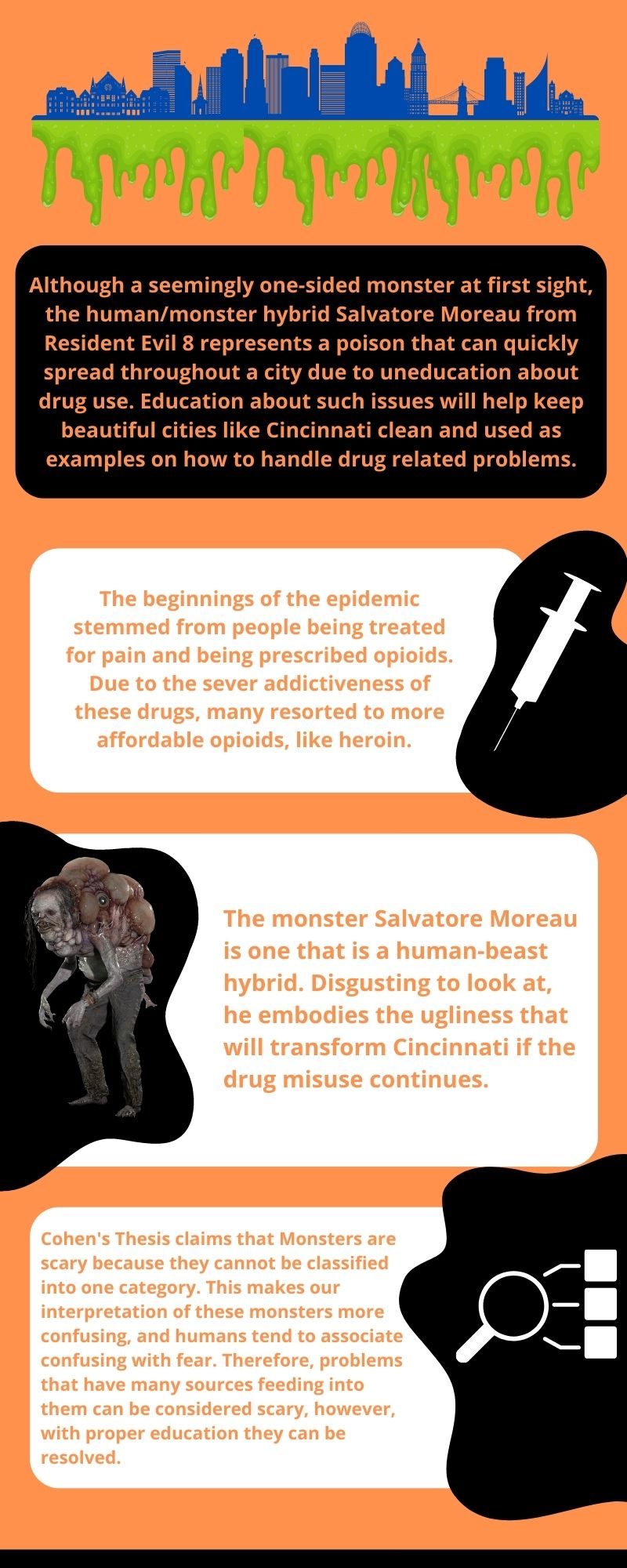9 Cincinnati’s Opioid Monster
Nick Smyth
Cincinnati’s Opioid Monster
The First Phase

The Second Phase
In seven days- 18 deaths, 180 overdoses, and 15 are babies born with health problems, all due to opioid misuse in the Greater Cincinnati area. Opioid misuse has disproportionately affected the greater Cincinnati area due to features of the built environment such as parks, commercial and manufacturing areas, downtown development zones, etc. The opioid problem can be reflected in the seemingly simple human/monster hybrid Salvatore Moreau from Resident Evil 8. He is a physical representation of the problems that can quickly spread throughout a city when it is uneducated about opioids and has a drug misuse problem. Educating cities about such issues will help keep beautiful cities like Cincinnati clean and used as examples of how to handle drug-related problems. Educating the public and providing safe options for drug users will lead to a cleaner and more enjoyable city.
Ohio is one of the states most heavily affected by the opioid epidemic. The highest number of overdoses in the US and the opioid capital of the US are located in Ohio. Both cities are located an hour and a half from Cincinnati. The problem originated in the 90s with the over-prescription of opioids for patients in the greater Cincinnati area. As research came to light on the addictiveness of the drugs, it was already too late. To combat the problem, legislation was passed to reduce the number of prescriptions allowed. Now that access to such drugs was not as readily available, consumers turned toward what they did have access to. Unfortunately, what they had access to are less safe and more harmful opioids like heroin. These factors contributed to the increasing deadliness of the problem.
Some of the biggest factors that contribute to Cincinnati’s problem are due to its demographics as well as its built environment. The city has a high population of white males aged 30-39 who are more likely to experience an opioid-related overdose. The large industrial areas and development zones also lay key roles in the epidemic. Having large spaces that are void of people for most of the day provides opportunities for people to take higher doses of drugs like heroin without the risk of being bothered. However, not having someone around is much more dangerous because if something goes wrong you have no one to help you, ie. administer Narcan. The problem is unfortunately evolving into something harder to stop. The reason behind this evolution is the fact that people are confused as to exactly what is happening with the crisis.
As Cohen explains in his 3rd thesis, “Monsters are the harbingers of the category crisis.” This can be interpreted as some monsters don’t fit into any particular category, so they are confusing to us because we don’t understand them. Humans tend to be scared of things that they do not understand and label such things as monsters. People tend to not understand the situations drug users are put in and use their previous biases to group them into a single category. A great example is people always trusting doctors and never trusting drug addicts. While I’m not saying to do one or the other, there have been cases where doctors can’t be trusted or drug users have been put into certain situations against their own will. In the case of Cincinnati, many people don’t want to become educated on the matter and remain confused about the issues at hand.
Another way of understanding Cohen’s category crisis is through a close analysis of the song “Eyes Without a Face” by Billy Idol. The song starts with the line, “I’m all out of hope”. The verse is paired with a more nostalgic feel through acoustic guitar and represents a longing for someone who isn’t there. The song affirms this with lyrics about longing for a partner. “Don’t call me on the phone to tell me you’re alone.” This sets up the song for the bridge and is heavily reliant on electric guitar which represents his trips, both psychedelic and physical, where he becomes disjointed from his partner but towards the end of the trip he comes back to terms with himself. The bridge ends and goes back to the chorus and acoustic guitar. This connects to the thesis of the category crisis because the persona is conflicted in his views of whether or not he wants to be with his partner or not. A problem that evolves within the song and whose mood is heavily categorized based on the instrumental and lyrics.
This problem evolves. Evolving problems are evident in many places, including entertainment. In the videogame, Resident Evil 8 you have the chance to fight Salvatore Moreau, a grotesque amphibious human/creature mutated by an infectious fungus. When you thought it couldn’t get worse, he evolves into a giant fish-like monster that spits acid and attempts to burn you. However, the creature is simpleminded in that he is just doing what he thinks is right for his mother saying, “Oh Mother Miranda… if it’s for you, I’d do anything!” and “Watch me, Mama!” Resident Evil Village. Xbox X/S, Capcom, 2021. These quotes play a key factor in understanding Moreau’s complexity as a character. He will do everything in his power to please his mother because he doesn’t know any better. He is also a former human that was manipulated and turned into the creature he is within the game. These two factors tie into the opioid crisis in Cincinnati as they both share similar elements in how they interact with their surroundings.
Various factors such as the built environment and miseducation within both medical and public fields lead to unnecessary fear of the problem at hand. This fear then turns into the inability to find a solution to the problem. Without a solution, an evolution of the problem occurs, similar to that of Salvatore Moreau. However, by becoming educated on the issue, a solution can be found and the monster can therefore be defeated.
Boss Phase

